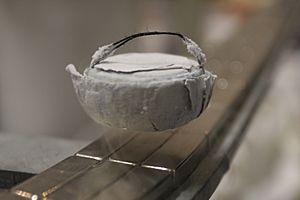Superconductor facts for kids
A superconductor is a very special material that lets electricity flow through it perfectly. Imagine a super-smooth slide for tiny electric particles called electrons! When electricity moves through most materials, it faces some "friction" called resistance. This friction makes the material heat up and wastes energy. But in a superconductor, there is absolutely no resistance, so electricity can flow forever without losing any energy.
This amazing trick only works when the material is made super cold. The exact temperature needed, called the critical temperature, is different for each material. Most everyday materials are not superconductors.
Another cool thing about superconductors is something called the Flux Trapping Effect. This effect can make a magnet float right above a superconductor that has been cooled down. It's like magic, but it's actually science!
Contents
How Superconductors Work
No Resistance: A Perfect Path
Think of electricity as water flowing through a pipe. In a normal pipe, there's always some friction slowing the water down. This is like electrical resistance. But in a superconductor, it's like the pipe becomes perfectly smooth and frictionless. The electrons can zoom through without bumping into anything or losing energy. This means they can carry electricity much more efficiently than regular wires.
Super Cold Temperatures
For a material to become a superconductor, it needs to be cooled down a lot. Some materials need to be cooled to extremely low temperatures, close to absolute zero (the coldest possible temperature in the universe!). Others, called "high-temperature superconductors," can work at slightly warmer, but still very cold, temperatures, often using liquid nitrogen to cool them.
Floating Magnets: The Meissner Effect
One of the most exciting properties of superconductors is how they interact with magnets. When a superconductor is cooled below its critical temperature, it pushes out any magnetic fields from its inside. This is called the Meissner Effect. If you place a magnet near a cooled superconductor, the superconductor creates its own magnetic field that pushes back, making the magnet float or "levitate" above it!
Uses for Superconductors
Superconductors have many exciting uses because of their unique properties.
Super-Fast Trains
One famous use is in maglev trains (magnetic levitation trains). These trains use powerful superconducting magnets to float above the tracks. Because there's no friction with the tracks, maglev trains can travel incredibly fast and smoothly.
Powerful Magnets for Science and Medicine
Superconductors can create extremely strong magnetic fields. These powerful magnets are used in many important areas:
- Medical Scanners: They are key parts of MRI (Magnetic Resonance Imaging) machines, which doctors use to see inside the human body without surgery.
- Particle Accelerators: Huge science machines like the Large Hadron Collider at CERN use superconducting magnets to guide tiny particles at nearly the speed of light, helping scientists learn about the universe.
Efficient Power Grids
Because superconductors have no resistance, they can carry electricity without any energy loss. This means they could make our power grids much more efficient. Imagine power lines that don't waste any electricity as it travels from the power plant to your home! This could save a lot of energy and money.
History of Superconductivity
The discovery of superconductivity happened over 100 years ago!
- In 1911, a Dutch scientist named Heike Kamerlingh Onnes was studying how materials behave at very low temperatures.
- He cooled mercury to about -269 degrees Celsius (just a few degrees above absolute zero).
- To his surprise, he found that the mercury's electrical resistance completely disappeared! This was the first time anyone had seen a material become a superconductor.
- His discovery opened up a whole new field of physics and led to many amazing technologies we use today.
Images for kids
-
A magnet levitating above a high-temperature superconductor, cooled with liquid nitrogen. Electric current flows on the surface of the superconductor, pushing away the magnet's magnetic field.
-
Heike Kamerlingh Onnes (right), who discovered superconductivity. Paul Ehrenfest, Hendrik Lorentz, Niels Bohr are also in the picture.
See also
 In Spanish: Superconductividad para niños
In Spanish: Superconductividad para niños







